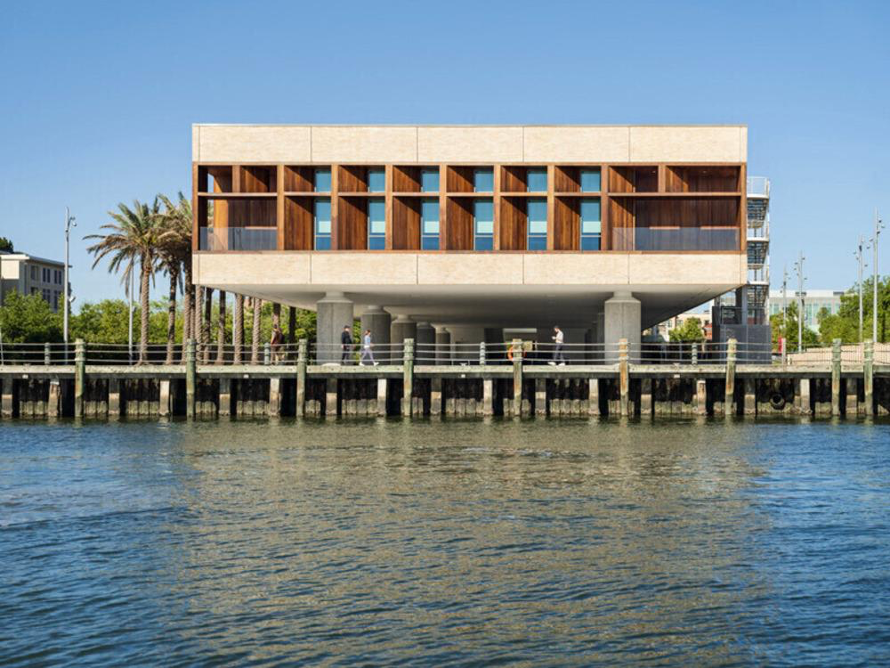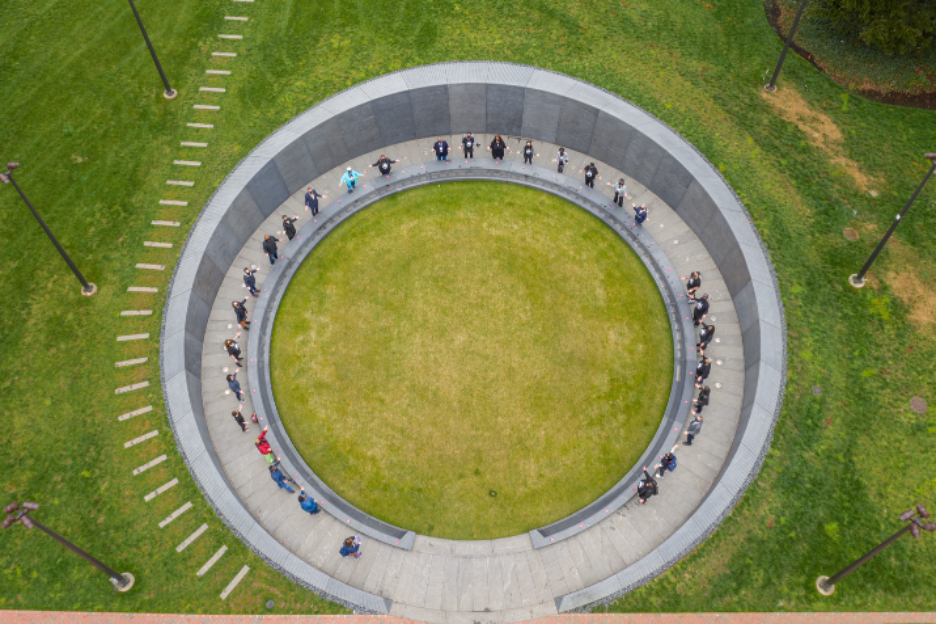Committee co-chairs reflect on priorities for 2025 and the importance of honoring enslaved people through memorialization

Last month, Brenda Tindal, co-chair of the Harvard & the Legacy of Slavery Initiative’s Memorial Project Committee, and Sara Bleich, vice provost for special projects and the leader of the Initiative, took part in a listening session at the University’s annual forum.
Bleich described how creating a campus memorial to honor the enslaved people whose labor facilitated the founding, growth, and evolution of Harvard represents one of the three near-term priorities of the H&LS Initiative, alongside prioritizing partnerships with historically Black colleges and universities and supporting descendant communities. Tindal, who is also the Faculty of Arts and Sciences chief campus curator and senior adviser on academic community engagement to the dean of FAS, spoke about the significance of memorials in honoring the past and the future.
During the Q&A session that followed, about 30 people shared their hopes for the campus memorial. “The insights from the University’s forum were a reminder of the important dialogue and learning that stem from the Report of the Presidential Committee on Harvard & the Legacy of Slavery,” Tindal said. “The Harvard community’s eagerness to create the memorial was palpable, and we heard the need to humanize the narratives of those enslaved on our campus, while fostering dialogue and reflection that invites engagement with the broader community.”
As leaders of the H&LS Memorial Committee, Tindal and Eric Höweler, director of the Master of Architecture I program and a professor of architecture, Harvard Graduate School of Design, lead the H&LS Memorial Committee – engage and consult a group of experts in African diasporic history and culture, Native American and Indigenous studies, law, design, and divinity. They were appointed as co-chairs in September 2024, succeeding Tracy K. Smith and Dan Byers.
In the interview that follows, Tindal and Höweler shed light on the Memorial Committee’s priorities for 2025: establishing the time and process to create a campus memorial, and making community engagement on campus, in Cambridge, Boston, and beyond the backbone of this multi-year effort.
Why do memorials matter especially in the context of a university’s reckoning with its history of slavery?
Tindal: I think memory matters. We live in a society where things come and go quickly. And I think memorials tend to signal permanence and a durable reminder of the past in the present. Harvard’s campus includes a memorial ecology that helps to convey an institutional narrative, which in turn, makes our campuses cultural heritage an extension of the intellectual enterprise. I think it is really exciting to be able to place this very complex narrative into conversation with the histories that are currently legible on campus. History is not always about the victors. Sometimes it is about telling those hard narratives and stories and centering individuals who shape or contribute to our history, telling a much more nuanced narrative of our institution. I think it’s going to add dimension to what stories already make up our campus memorial ecology and it will be a very interesting dialectic with the stories that make up the City of Cambridge and Boston. It will be a destination for those outside of the Harvard ecosystem who hope to pilgrimage to our campus to visit the memorial.

Höweler: As an architect, I would say [that] our buildings, design objects, and artifacts are our works of art, [and] our ways of inscribing values in a durable sort of medium. So every building we build, in a way, reflects our set of values. In reading the Report there’s this idea of truth and truth telling. Where are sites for that? Are they situated, or are they abstract? And I think architecture occupies space, it occupies time, and it does bring people together. It convenes people around subject matter, content and around these stories that need to be told.
Harvard & the Legacy of Slavery Initiative’s Memorial Committee was established in 2023. Who makes up the Memorial committee and what is your charge?
Tindal: One of the incredible virtues of the Memorial committee is both our remit and the incredible people who serve on the committee. Members of the committee represent a broad range of expertise, from the Law School, to the School of Divinity, the department of History and African American Studies, museums and other collection holding entities like the library and art museums. There’s also representation from the Graduate School of Design as well as Harvard University’s Native American program. Our charge is to help build on the important work of the broader H&LS Initiative and part of that is thinking about the ways in which this memorial will have enduring impact on the ways in which we remember and understand the history and legacy of slavery at Harvard and in the world.
Höweler: As an architect and as a designer I feel like there’s the H&LS Initiative’s mission and then there’s the materialization of that in the world. And I feel like transforming the mission into a physical thing, into a material thing, and into a place of learning is the larger project of the memorial. I think the committee is building a kind of intellectual framework for the future building of a memorial on campus and that is incredibly powerful.
What are the major considerations that you have to keep at the forefront as you shepherd the task of erecting a memorial honoring the enslaved people whose labor facilitated the founding, growth, and evolution of Harvard?
Höweler: This process of honoring enslaved people through memorialization is meant to right historical wrongs. There’s got to be the right amount of outreach, the right amount of engagement, so that it cannot reproduce something that it’s meant to overcome or correct. And so there’s a lot of thinking about, “What does a just process look like?” and “How are memorials commissioned traditionally?” and “How could we imagine a process that would yield a different outcome through a different process?” And I think that’s one of the things where we’re tasked with very pragmatically: How do we get the right team together? How do we invite the right stakeholders to the table? And so that makes me think that it can’t be rushed, and that we have to go at its own pace. So designing a process, I think, is part of what we’re doing. I would say, we’re not designing a memorial. We’re designing a process that will yield a memorial. That’s a minor point, but I think it’s an important one, because it begins with injustice, and we have to overcome that with a process that is fair and just.
Tindal: I think that engagement is an important part of cultivating and implementing a process that will yield our greatest hopes and dreams as it relates to the memorial, and part of that is interfacing with descendant communities, including Indigenous, Native and Black people. And that has to be done very carefully, and in some ways it has to be done through the lens of a trauma-informed approach. So for me, it’s important to think about creative ways to engage our on campus audience in a way that is not just about yet another memorial or another monument, but also ensuring that there is some ceremony, that there is some ritual, there’s some annual and engagement with the histories, and that we hope to bring into sharper focus through the memorial.
What are you prioritizing for 2025?
Höweler: I think we’re, in a way, finding our footing intellectually and collectively. We’re going to make sure we engage with the right communities. I think it’s a continuous process of engagement. The committee is meeting at a regular cadence. We’re getting to know each other, and, in a way, doing some deep sharing, which I think is important to build trust. We’re going to travel together to sites and learn from each other. Our goals are not to rush to get that done but to build a kind of collective imagination of what this thing could be, and we don’t want to have preconceptions or rush to conclusions. I think this is a once in a lifetime chance, and we want to make sure we’re getting as close to right as possible.
Tindal: If I had to summarize, there are three major priorities for 2025. One is really energizing the committee and being in thought partnership as we design a process. I think being able to launch a much more comprehensive community engagement strategy and also participate in site visits, as Eric alluded to, will help us think about how the broader national memorial ecology is grappling with aligned memorials. We hope to also convene a few programs that will invite thinking from curators and creatives and other stakeholders involved in the creation of memorials.
Can you talk about a memorial that has a lot of meaning to you. And how long a project like that typically takes from start to finish?
Höweler: The University of Virginia’s Memorial to Enslaved Laborers is a recent memory, which did take a lot of time. And there was a process for selection, and it was a fair process. There were seven or eight years of pre-work that were done before, and I think that’s important because an RFP can seem like you’re checking a box. I do think memorials have evolved. You can look at a representation of someone who’s supposed to be John Harvard, and you know, there’s a likeness, there’s a resemblance, but you can look at the Vietnam Memorial, and that’s just something you feel in your stomach. It’s not an image. It is an experience. We went from representational to abstract, and now we’re asking, how do people identify with memorials? How do they see themselves in them? I think for people to see themselves in them, we have to imagine their experiences and the insufficiency of abstraction, sometimes the desire for recognition, for recognizability. That’s a version of an outcome that I think is inspiring: The [memorial] that learns from history but also looks to a different future.

Tindal: The memorial that has had the most meaning for me was the International African American Museum. This is the last project that I worked on before coming to Harvard and [it] took 20-plus years with the deliberative process of working within the context of a municipal and a community, and also international contours. But there have been many exhibitions that mean something to me. I remember working on the Alice Walker papers project at Emory University and on this little sticky note, in Alice Walker’s long hand, it said “people are known by the records they keep. If it isn’t in the record, it will be said that it did not happen. That’s what history is, a keeping of records” –and I see the memorial landscape as an opportunity to help us or to remind us of our shared history. Slavery is not just history for a particular group. It’s all of our history.
For more information, contact Julita Bailey-Vasco, Senior Associate Director of Communications, Harvard & the Legacy of Slavery Initiative, at julita_bailey-vasco@harvard.edu.
